Next-generation sequencing (NGS) is a powerful, high-throughput technology widely used to determine the sequence of DNA or RNA to gain insights into genetic variation, gene expression, and genomic structure. The NGS workflow encompasses several distinct steps, from nucleic acid extraction through to data analysis, enabling massive parallel sequencing of millions to billions of DNA fragments with high speed and accuracy.
Nucleic Acid Extraction
The first step involves isolating DNA or RNA from the biological sample. High-quality and sufficient quantity nucleic acid extraction is critical, and purity is typically assessed by spectrophotometry (A260/A280 ratios around 1.8 for DNA and 2.0 for RNA). Samples can include cell cultures, tissue biopsies, blood, or other sources. Extracted nucleic acids must be clean, intact, and free from contaminants to ensure successful downstream processes.
Library Preparation
Library preparation is a crucial step that transforms extracted nucleic acids into a sequencing-ready format. This involves several sub-steps:
- Fragmentation: DNA or RNA is fragmented into smaller pieces of a defined size (commonly 100–300 base pairs) using mechanical shearing (sonication), enzymatic digestion, or chemical methods.
- End Repair and A-Tailing: Fragmented DNA is repaired to create blunt ends, often with the addition of an ‘A’ nucleotide overhang to facilitate adapter ligation.
- Adapter Ligation: Specialized adapters with platform-specific sequences are ligated to fragment ends. These adapters enable amplification, sequencing priming, and sample barcoding (indexing) for multiplexing.
- Amplification (optional): PCR amplification enriches the adapter-ligated fragments to create a sufficient amount of library DNA.
- Size Selection and Purification: Libraries are purified and size-selected to exclude undesired fragment sizes, ensuring optimal sequencing performance.
Library preparation protocols may vary by sequencing platform and application but typically follow these core principles.
Sequencing
Prepared libraries are loaded onto the sequencing platform. For Illumina technology (the most common platform), sequencing is performed by sequencing-by-synthesis chemistry, where nucleotides labeled with reversible fluorescent markers are incorporated into the DNA strand. A camera records the fluorescence signals, each corresponding to a specific base, in a massively parallel fashion across millions of clusters on a flow cell.
Other platforms, such as Oxford Nanopore, sequence by measuring changes in electrical current as single-stranded DNA passes through a nanopore, while PacBio uses real-time fluorescent detection of nucleotide incorporation. The sequencing generates millions to billions of short or long reads depending on the platform and application.
Data Analysis
Raw data from sequencing are processed through bioinformatics pipelines. Key steps include:
- Quality control to filter low-quality reads
- Alignment or assembly of reads against a reference genome or de novo assembly
- Variant calling to identify mutations or polymorphisms
- Expression analysis for RNA sequencing
- Functional annotation and interpretation to draw biological conclusions
Advanced integrated data platforms enable secondary and tertiary analyses tailored to the research or clinical question. This NGS protocol framework provides a robust approach to high-throughput genetic analysis across many biological research and clinical diagnostics applications. Each step requires meticulous optimization of reagents, inputs, and conditions to maximize accuracy, coverage, and reproducibility.



